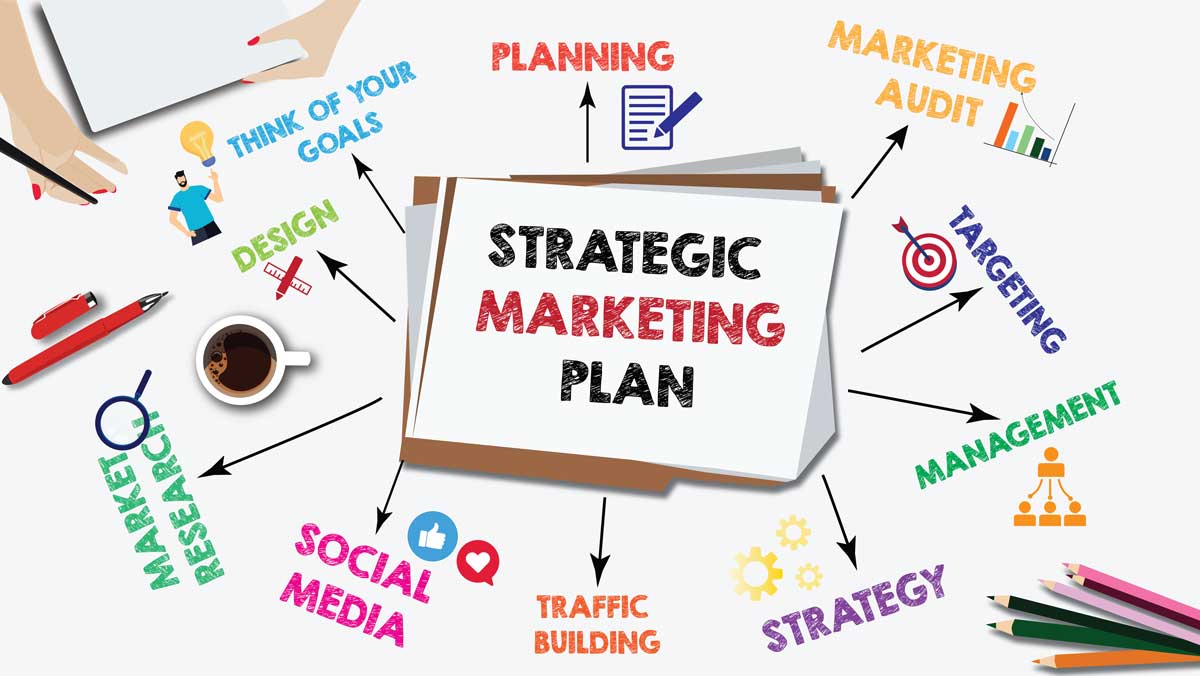Smart marketing strategies to help your business stand out from others in a saturated environment.A strategic marketing plan is an extensive, full-scale outline representing the advertising and marketing efforts of a company, brand, or organization. Based on audience analysis and industry research, this ultra-focused, comprehensive plan provides a step-wise guide to help companies promote their offerings to a target market of existing and potential clients.
The success of a business is determined to a great extent by the success of its marketing plan. This discussion is aimed at helping you with fresh ideas presented systematically to kick off those much-anticipated marketing plans or update existing ones.
Why is a strategic marketing plan needed?
A strategic marketing plan enables business owners to determine their target audience and plan how best to sell their products using selective intent and marketing techniques to maximize returns on investment while condensing sales cycles via ROI analysis. Developing a strategic marketing plan serves diverse purposes in business, including:
- Clearly defines the objectives of the business or the company to establish realistic goals consistent with their objectives in a defined time span within the organization's financial capacity for implementation.
- Represents a clear picture of the organization's identity and defines how it is different from its competitors
- Evaluates the strengths, weaknesses, and opportunities of the organization.
- Ensures the most productive use of the organization's resources by focusing them on the key priorities.
- Establishes a benchmark against which success can be measured and provides a mechanism for informed alteration if needed.
- Bridges the gap between the employees of the organization, promoting teamwork and a collaborative environment.
Components of the strategic marketing plan
A successful marketing plan is formulated following mindful research and careful consideration. Given below are eight steps to be taken to develop a well-crafted strategic marketing plan bound to result in a successful outcome.
1.Think of your goals
If a student fixes his academic goals before preparing for an exam, the result will likely be better because the preparation will be targeted toward achieving that goal. Same way, once you’ve decided to start retailing, you need to set pragmatic and measurable goals to achieve over the course of the next year or so. Setting a target to be achieved within a set time span allows you to plan marketing activities that match your marketing goals. Suppose you own an online business of selling vintage decor on a social media platform; think about the number of followers you would like to have over the next year, and the amount of profit you would like to generate that is both achievable and satisfies your business objectives. Remember to share these goals with your staff members, as your staff needs to support your efforts to make the goals achievable and the marketing plan successful.
2. Implement a marketing audit
A marketing audit is a systemic, periodic, and comprehensive evaluation of your marketing techniques, activities, and goals. By conducting marketing audits, you can examine how your marketing strategy is planned and how it is operating relative to your marketing goals. Suppose you and your friends are headed to the beach in a car for a long weekend. You have packed your things, filled the car tank, and looked at the directions on a map. Two hours into the journey, you are desperately lost. You realize that somehow your directions are inaccurate, and you have ended up on a route far away from the one you should be on. What do you do? You pull over, reassess your route, and check the map again for the correct direction. After some time, you are back on track with the beach closer than ever. Checking on the direction you are heading and making readjustments if necessary is essential for getting back in touch with your brand and services, re-focusing your marketing activities, and reminding you of your initial goals and objectives.

3. Conduct market research
Market research aims to draw a realistic picture of your business, the industry, and your current position in the industry. With this data, you can identify and evaluate how changing elements in the industry impact customer behavior. You can also recognize competitive factors and explore non-traditional marketing to reap maximum benefits. Although market research is the most time-consuming step in the marketing process, it is also one of the most important.
4. Evaluate your research
Once you are done with your research, evaluating the raw data you just collected and summarizing it into consequential findings is important. It will act as the determining factor in deciding on marketing strategies that will reap the best outcome for your business. The research analysis should identify the needs of your current and potential clients and help you define your target audience. You may need to modify some of your goals and marketing activities based on your research analysis.
5. Identify your audience
If you fail to identify the best fit for your product, you will have difficulty marketing it. Identifying your target audience allows you to focus your marketing activities and minimizes the chances of failure of your marketing campaign. It also helps you build relationships with your customers to communicate with them better. For example, if you have a company that sells luxury beauty products, your target audience would be working females between the ages of 20 and 35, interested in self-care, with a monthly income above 40,000 INR. It does not mean that females outside this range will not buy your products or can not afford them, but while defining a market, the best way to conclude is to generalize the subjects and target the most probable audience.

6. Decide on a budget
You set the goal, did your research, and know your audience; now, what should your next step be? Examining your financial information and coming up with a marketing budget. There are many factors that could define a marketing budget, including the type of industry, the age of your brand or company, and the previous marketing history. While there is no standard for how much you should spend on your marketing activities, keeping aside three to five per cent of your gross annual income for marketing expenses has proven fruitful for many. Having said that, if you are operating in a highly competitive environment and your business is new, or if you intend to roll out a new venture or service, you can keep aside 10 per cent or more of your annual gross income for the first year to achieve successful results. This is because some of the initial marketing expenses can be quite high. For example, it could cost more than 100,000 INR to have a corporate image package designed by a professional. On the other hand, some other marketing activities cost next to nothing. Big or small, these are all productive investments that will present a positive image of your brand to your audience.
7. Formulate marketing strategies
With your budget decided, you can begin to formulate specific marketing strategies aligning with your goals that will help you reach your target audience and build your client base. Do not forget to focus your strategies on the elements of your brand to create a special value in the minds of your audience. Each strategy you formulate should back a specific goal. For example, one strategy related to increasing customer satisfaction might be to increase the number of customer care executives to handle every complaint and query of the customers efficiently.
8. Devise an implementation schedule
The implementation schedule is the timetable that defines the time to execute your marketing strategies and also mentions the responsible person for executing them. The schedule should also include the expense of each marketing activity and how it is in alignment with the annual budget estimates. The implementation schedule will form a base for you to monitor the progress of your marketing plan.
10. Evaluate the results of your strategy
The worth of a marketing plan depends on its effectiveness. To measure that, deliberate and timely implementation of the marketing activities is required, along with periodic monitoring and evaluation of results against the standards you set while establishing your goals. There are several ways to track the results, including increased follower base and income and decreased complaints.
Conclusion
A well-built marketing plan outlines practical and realistic business goals, strategies, and activities based on sound information and thorough analysis and evaluation of your business and the community. However, the plan is only as good as your dedication and commitment to implementing it, arranging sufficient resources for the venture, and bridging the gap between you and your staff members through constant communication. The marketing plan should not only be prepared, written, reviewed and forgotten about. Rather, it should act as an evolving blueprint that guides your valuable efforts and monitors your progress. With hard work and dedication, success follows unintentionally!
FAQs
1. What is the aim of conducting market research?
Market research gathers, records, and analyzes qualitative and quantitative information about your marketing products and services.
2. Why is evaluating the results of the marketing strategy important?
Evaluating the results of the marketing strategy is crucial to determine its efficiency. The information can be used to update the current strategy or formulate a new one.
3. Why is setting marketing goals important?
Setting marketing goals is important to achieve a successful outcome as the strategies will focus on achieving those goals.




